Sail up Singapore River and back in time at National Museum’s exhibition Once Upon A Tide
Sign up now: Get ST's newsletters delivered to your inbox
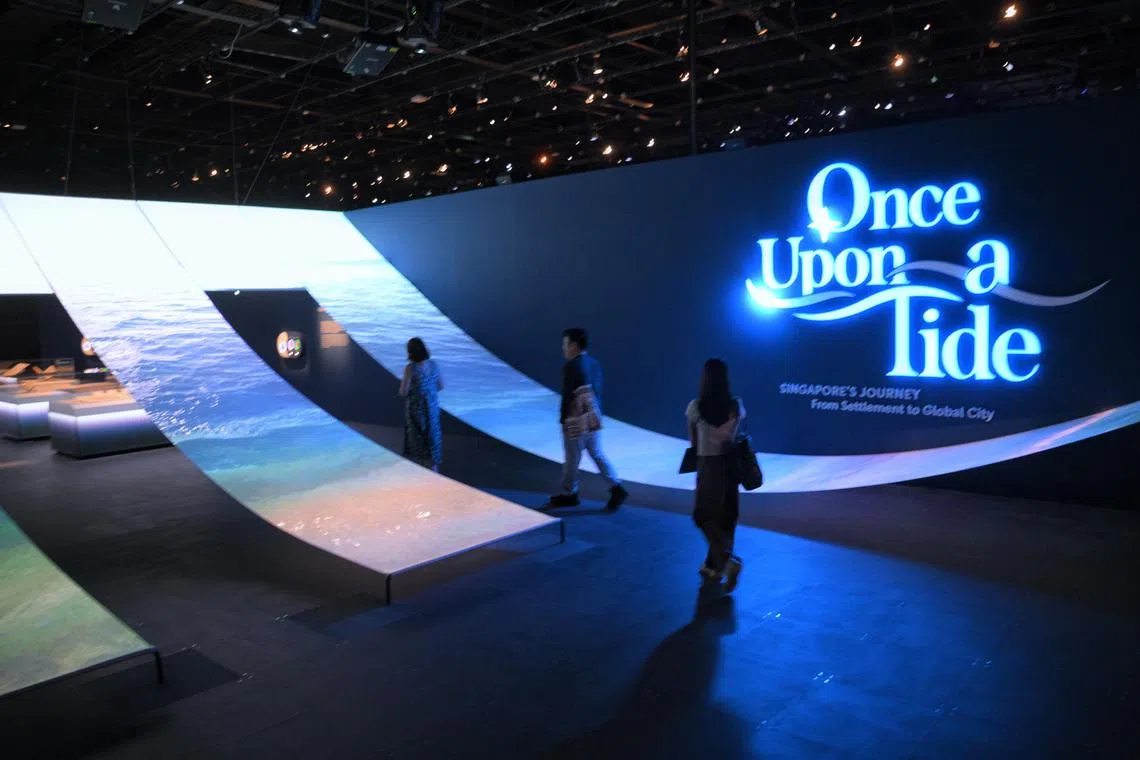
The National Museum Of Singapore’s new exhibition, Once Upon A Tide, traces the country's growth via the sea and its waterways.
ST PHOTO: MARK CHEONG
Follow topic:
SINGAPORE – Sail up the Singapore River and back in time at the National Museum Of Singapore’s new exhibition.
Once Upon A Tide: Singapore’s Journey From Settlement To Global City, which opens on May 24, traces Singapore’s growth via the sea and its waterways.
The story arc melds a tribute to SG60 with a potted history of the nation as the show is serving double duty during its run. The Singapore History Gallery will be closed at the year’s end for a revamp and will reopen in late 2026, so Once Upon A Tide will be the museum’s anchor show in the interim.
Mr Daniel Tham, 44, the museum’s principal curator for pre-colonial and colonial Singapore, says the sea references and fairy-tale element of the title are deliberate. “We want to reference our interest in storytelling as a museum. We are also referencing Singapore’s identity as an island, the importance of the sea and, later, the centrality of the Singapore River.”
Hence, the show begins with artefacts that literally map out historical references to the island now known as Singapore.
Mr Tham says: “We asked the question, ‘Has Singapore always existed?’ We’re commemorating 60 years as a nation, but obviously, Singapore’s history goes further back. How far back does it go?”
Pretty far back as the items on display suggest. The earliest reference is in second-century Greek astrologer and geographer Claudius Ptolemy’s illustrated Geographia, which famously calls the Malay Peninsula “the Golden Chersonese”.
A 16th-century reproduction print of Ptolemy’s map is displayed alongside stone tools unearthed at Pulau Ubin. These prehistoric adzes possibly date back 3,000 to 5,000 years. They were collected by Major P.D.R. Williams-Hunt, then the acting director of Museums for the Federation of Malaya in the late 1940s to early 1950s.
This first section of the exhibition also includes interactive displays where visitors can try locating Singapore on old maps which refer to the island variously as Singapur, Cinca Pura and Sabana.
Mr Tham notes that even if the island was not identified, the straits of Malacca and Johor, major waterways in the region, would be charted.
The island’s strategic position and the role of the Singapore River in its history form the next part of the story, and so the exhibition space has been designed to mimic the river, with a corridor that branches off into two tributaries for the subsequent chapters.
There is some effort to contextualise the British arrival, with a display that includes antique weaponry referencing the violence that marked colonisation in the region.
Mr Tham notes: “The British arrival in Singapore wasn’t marked by warfare, unlike in other places. But at the same time, local accounts mention sepoys being present with muskets.”
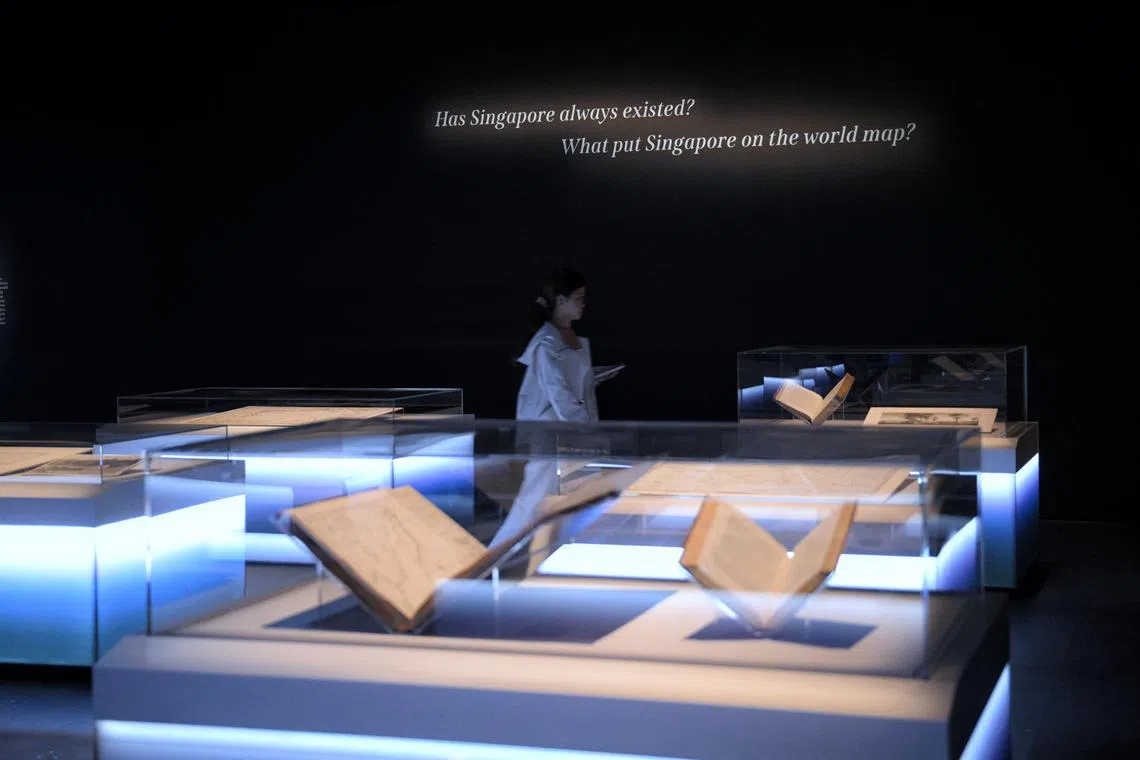
The National Museum Of Singapore’s new exhibition, Once Upon A Tide, traces the country's growth via the sea and its waterways.
ST PHOTO: MARK CHEONG
The main focus, however, remains on how trade, people and technology flowed through Singapore waters, supporting its development through the 19th and 20th centuries.
How Singapore got bigger – literally and metaphorically – forms a running theme for the rest of Once Upon A Tide.
The chapter titled Expanding Horizons will intrigue visitors who think of reclamation as a recent modern phenomenon in Singapore history.
The first major land reclamation project was undertaken in the 1880s by the British colonial government. Telok Ayer Bay was filled in with soil dug from Mount Wallich. Look out for old photographs taken of the area before, during and after the process, as well as a map documenting urban planning for the reclaimed land.
A more familiar narrative comes in the chapter titled Flows Of People, which showcases the stories of early immigrants. These range from Chinese labourers to Indian civil servants.
Mr Tham highlights a gift from the family of police constable Lall Singh, who came to Singapore as part of the Sikh contingent. This includes a typewritten letter from Mr Singh to the colonial authorities in India, requesting his retirement pension be sent to Singapore, as he had chosen to remain here.
Once Upon A Tide closes with more current items, some of which were gathered as part of the museum’s Collecting Contemporary initiative. These include Olympic champion Joseph Schooling’s autographed swim trunks and athlete Shanti Pereira’s bright fuchsia running shoes.
There are also highlights from Singapore’s cultural icons, from an outfit by designer Benny Ong – who dressed Britain’s late Princess Diana – to musician and Cultural Medallion recipient Margaret Leng Tan’s iconic toy piano.
These items reflect how this island nation has made its mark on the wider world.
As Mr Tham says: “The show’s opening is a bit mysterious – it asks if you can find Singapore in these old maps. Then you sail through the river, and you see Singapore’s development as it’s mirrored by the story of the river. Eventually, you sail out into the open sea with a bit more of our recent history, and we talk about how Singapore has made an impact on the world.”
Book it/Once Upon A Tide: Singapore’s Journey From Settlement To Global City
Where: National Museum of Singapore, 93 Stamford Road str.sg/tibs
When: May 24 to Oct 9, 2026, 10am to 7pm daily
Admission: Free for Singapore citizens and permanent residents, from $18 for foreigners
Info:
Five highlights at Once Upon A Tide
1. Daguerreotype of Singapore, showing a view of Boat Quay (1844)
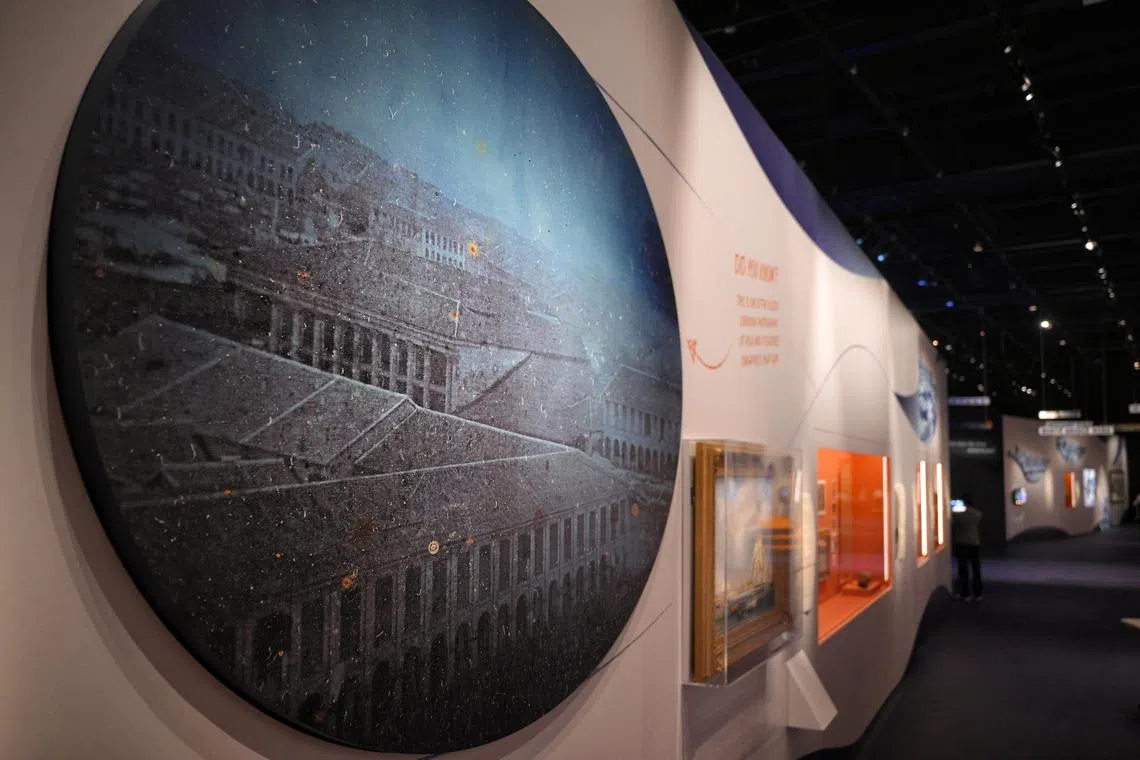
An enlarged version of a 1844 daguerreotype of Singapore showing a view of Boat Quay at Once Upon A Tide.
ST PHOTO: MARK CHEONG
Blink and you will miss this tiny oval daguerreotype tucked into a display with a couple of antique weapons and views of Singapore. This is one of the earliest surviving photographs of Singapore. Shot from Government Hill, now Fort Canning Hill, it shows Boat Quay, packed with warehouses and buildings.
As an international port for goods, Singapore was also plugged into global technological flows. This image was taken just five years after the daguerreotype photographic technique was invented.
2. Skyline of Singapore in 1976 (1977) by Lai Kui Fang, oil on canvas

Lai Kui Fang’s painting of Singapore’s skyline from the 1970s at Once Upon A Tide.
ST PHOTO: MARK CHEONG
This large painting, measuring 151.5cm by 339cm, is a photorealistic bird’s-eye view of the Singapore River and Central Business District. Everything from the then spanking new OCBC Centre to the Boat Quay shophouses to tiny buses are rendered in careful detail. It is a snapshot in time, capturing the massive and speedy development of the area in the short decade following Singapore’s independence.
Beyond its value as a historic document, what is also fascinating is the question of how Lai created this astonishing panoramic view. There is no single spot at that point in time where the artist could have stood to see this view, so he must have recreated the landscape from his imagination. There is also no single vanishing point on the canvas, with all the buildings, bumboats and buses in sharp focus. It is an impressive feat.
3. 1881 map of Singapore by Henry Edward McCallum, with handwritten annotations by Hancock Thomas Haughton
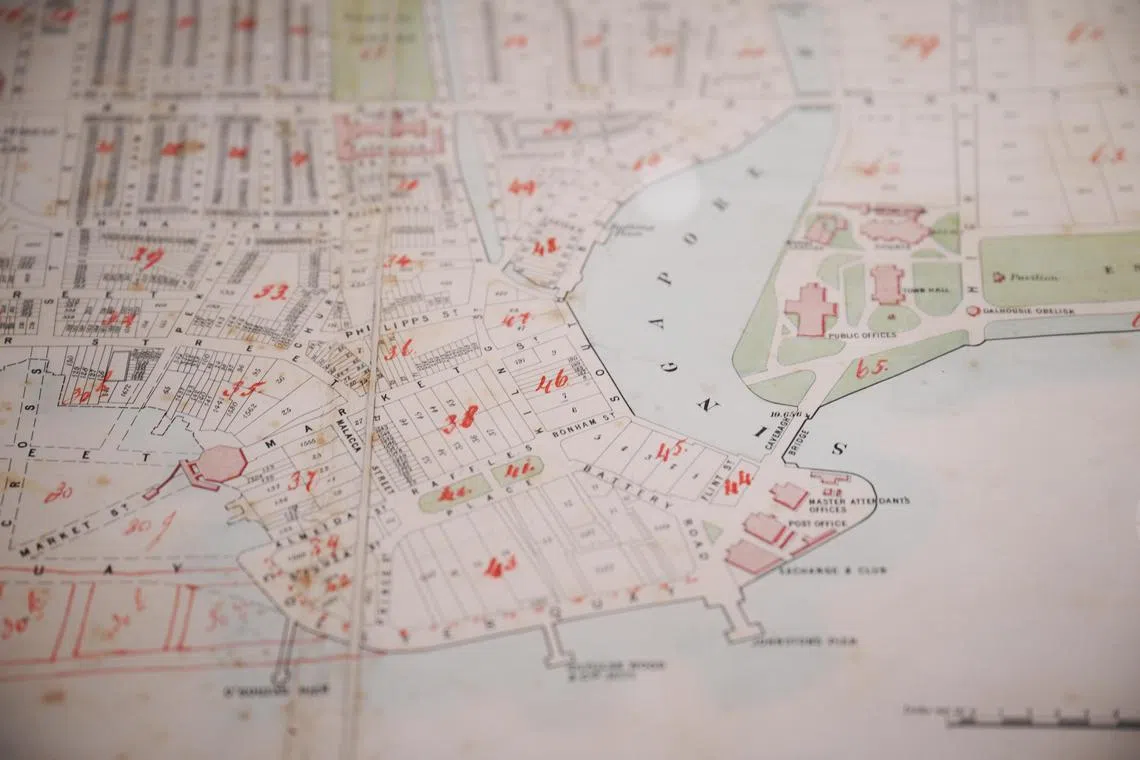
A map of Singapore at Once Upon A Tide.
ST PHOTO: MARK CHEONG
Henry Edward McCallum is responsible for designing the Raffles Museum building, now the National Museum of Singapore, and introducing electricity to Singapore. As colonial engineer of the public works of the Straits Settlements (1885 to 1897), he also produced this detailed map of Singapore’s bustling city centre.
Pay attention to the map’s title, and you will see the signature of Hancock Thomas Haughton, a civil servant who held multiple positions, including collector of land revenues, and who worked with McCallum. What is more intriguing are the notations in red, marking out road name changes for the land reclaimed from the Telok Ayer basin that became Singapore’s Central Business District in the 19th and 20th centuries. You can see amendments where Robinson Quay became Robinson Road, and further extensions for Raffles Quay.
4. Diorama depicting a coolie room in the 1900s (c.1983) by Mar Edjawan, Elmer Gernale and Arthur Concepcion, wood and metal
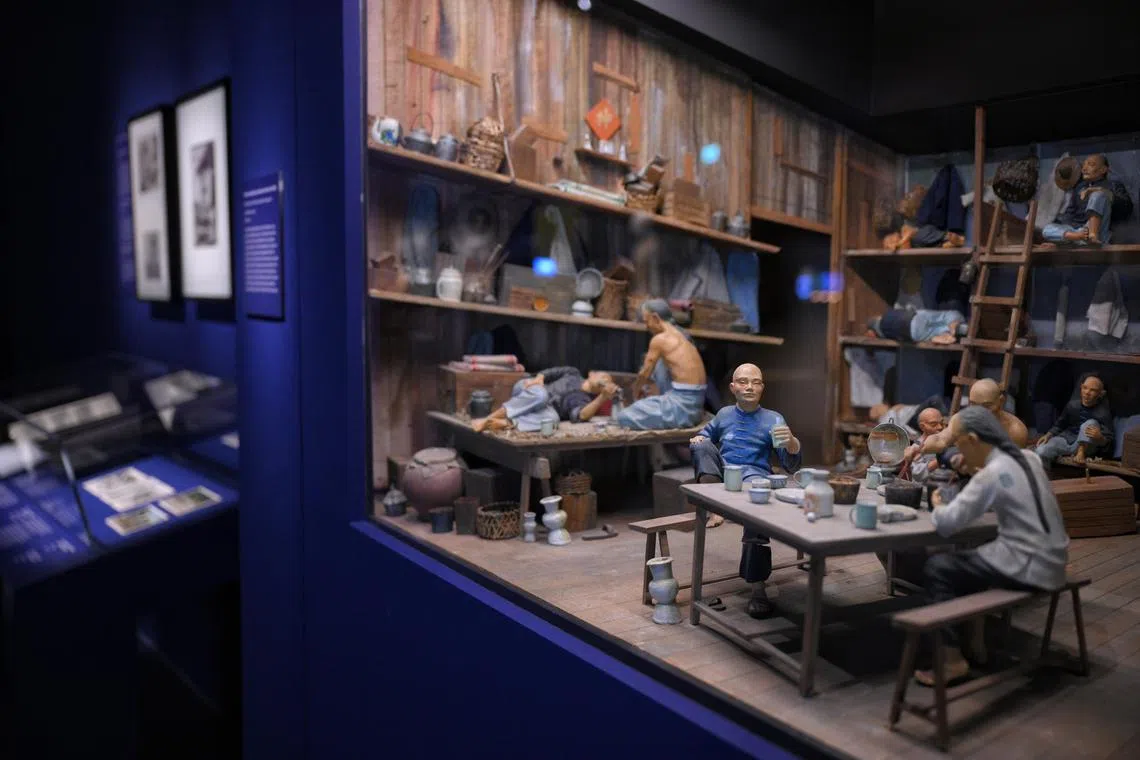
Miniature figurines depicting life in the time at Once Upon A Tide.
ST PHOTO: MARK CHEONG
Visitors of a certain age will recognise this diorama, a traditional style of museum display in the 1980s and 1990s. It is one of several dioramas the museum has saved from its old displays and captures in lifelike detail the quarters of coolie labourers. Check out the narrow three-tiered bunks, which crammed people in cheek by jowl. In real life, each bunk bed might even have been shared by two men sleeping in shifts, depending on their work schedules.
5. Majie Leong Kun Toh’s samfoo top and trousers (mid-20th century) cotton and silk
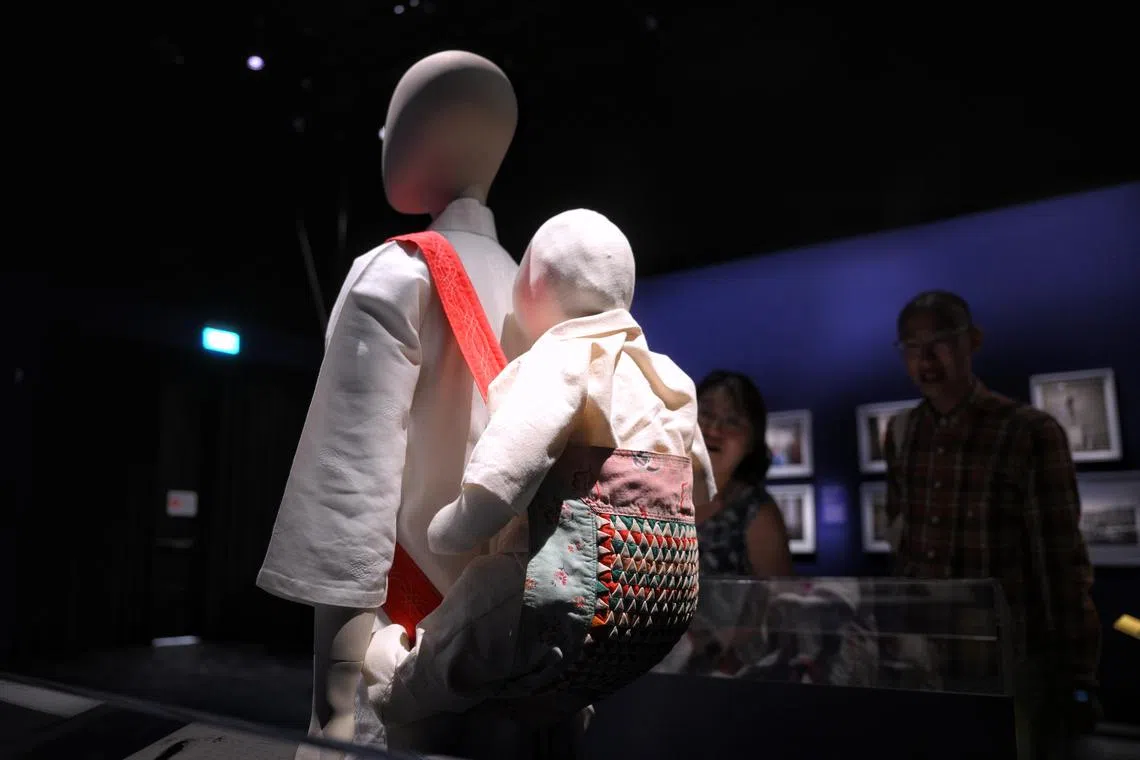
A mannequin with a black-and-white samfoo and a traditional Chinese patchwork baby carrier at Once Upon A Tide.
ST PHOTO: MARK CHEONG
This charming display, titled Traditional Chinese patchwork baby carrier (c.1950) fabric, will intrigue crafters. The baby carrier is a beautiful example of practical home sewing, with an attractive triangle patch pattern and straps that are quilted for strength and comfort. Note the touch of decorative embroidery on the straps.
The conservator sewed a baby doll to display this carrier, making sure it was lightweight so as to reduce wear and tear on the fragile fabric.


